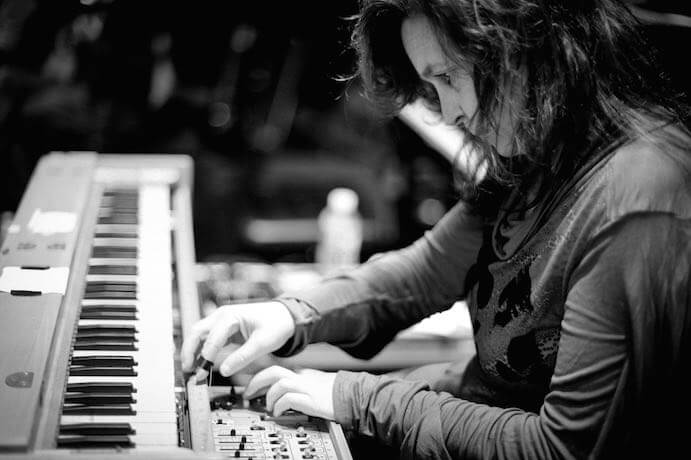“As long as I gaze on Waterloo sunset, I am in paradise.” Ray Davies of the Kinks’ lyrics are painted on the side of IKLECTIK Art Lab, which opened in 2014 and hosts experimental music and art events. Situated in Old Paradise Yard, tucked behind London’s Waterloo Station with a city farm and timber workshop as neighbours, its location can be sniffed out. This wonderfully quirky venue has mismatched chairs and old sofas, plants scattered around, and a small bar and bookshop.
Christine Ott’s evening performance on November 8, 2017 was the last of her debut tour of the UK. Based in Strasbourg, France, she is one of a tiny handful of performers on the ondes Martenot, and the opportunity to see and hear the instrument in an intimate setting was the main draw for this performance. The ondes Martenot was first demonstrated at the Paris Opera in 1928 by its inventor, Maurice Martenot (1898-1980), a radio engineer and amateur cellist. The instrument combines his enthusiasms: although its interface looks like a piano keyboard, conceptually it’s an electric cello, and like acoustic string instruments, it has the sustaining power of the human voice–though this is a voice with an unearthly sound, capable of producing notes far in excess of any human being.
The instrument survives as more than a museum curiosity largely thanks to Olivier Messiaen, who used it in several works including the massive Turangalîla symphony (1948), writing first for Martenot’s sister Ginette and later for Jeanne Loriod, the leading exponent of the instrument in the 20th century and Messiaen’s sister-in-law. It was never mass produced, and Martenot issued seven models in his lifetime. I had the privilege of making two short films on the instrument for London’s Philharmonia Orchestra: Stéphane Vaiedelich, laboratory manager of the Musée de la Musique in Paris which is restoring some old models, gave us a guide to the instrument, and Stéphane talks about his restoration work here.
Christine Ott
Christine Ott’s performance at IKLECTIK featured the ondes only in the second half, the first part being devoted to her piano compositions. An unassuming stage presence, she spoke little to the audience and did not introduce every item (and there was no printed programme). The vintage piano in IKLECTIK added another layer of nostalgic charm to her wistful minimal mood music. The music worked most effectively in tandem with film: Ott performed two of her movie soundtracks, for the Armenian Artavazd Pelechian’s short “The End” (1991) and extracts of the silent film “TABU” (1931), set in Francophone Pacific territories.
In “The End,” both piano and film were discontinuous, the film intercutting endless train carriages with more abstract images and brief glimpses of people travelling who knows where. The film faded out to an oscillating piano conclusion, though a soundtracked rumbling distant train surprisingly had the final word. “TABU” was a more obviously narrative-driven tale of forbidden love between a pearl diver and a beautiful young woman, and Ott’s sensitive accompaniment was largely in the treble register, as if pointing up the fragility of the island paradise.
The second half was devoted to Snowdrops, a 40-minute long semi-improvised duo project with the keyboard player Mathieu Gabry which was premiered in the Archeological Crypt in Paris (extracts are streamed here). Finally, we heard the ondes Martenot, alongside the piano, an electric keyboard, synthesizer and an ondomo – a portable mini-ondes, complete with carry handle.
SNOWDROPS from Camp de Base on Vimeo.
Whatever Messiaen thought, the ondes Martenot and piano are a difficult sonic combination to pull off. Ott demonstrated the full range of the ondes, highlighting its uniquely unsettling hybrid vocal/beyond vocal quality as well as its low buzzes and sweet tone with varying vibrato. The atmospheric ondes made the acoustic piano figurations sound prosaic by comparison, and the ondes’ sonority proved a better match with the electric keyboard. Gabry led the way with most of the synthesized sounds that bound the soundscape together. A distant wind tone sounded as if the music were being pulled into a tunnel from which the ondes emerged with its unearthly breathy sound. Often the ondes was underpinned by more rhythmically driven keyboard material, though the finest moments of the performance happened when Ott’s and Gabry’s sonorities reacted to each other, with the ondes becoming more incisive and the electric piano seeming to merge with the ondes’ ethereal sound world.
This was an enjoyable evening for lovers of retro technology. I would like to hear Ott again in a more substantial film soundtrack: the concert often felt that there was a narrative somewhere which was only half being told. And I will certainly go back to IKLECTIK which, if not quite paradise, is certainly a hidden gem in London’s contemporary music scene.

